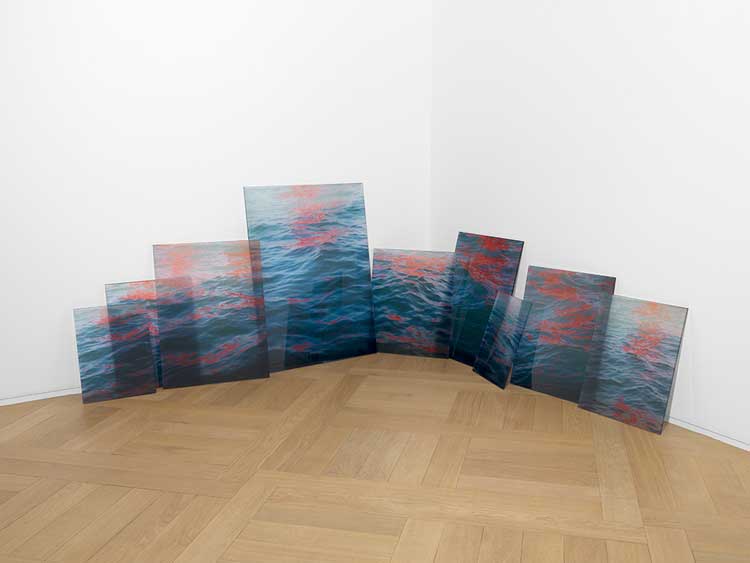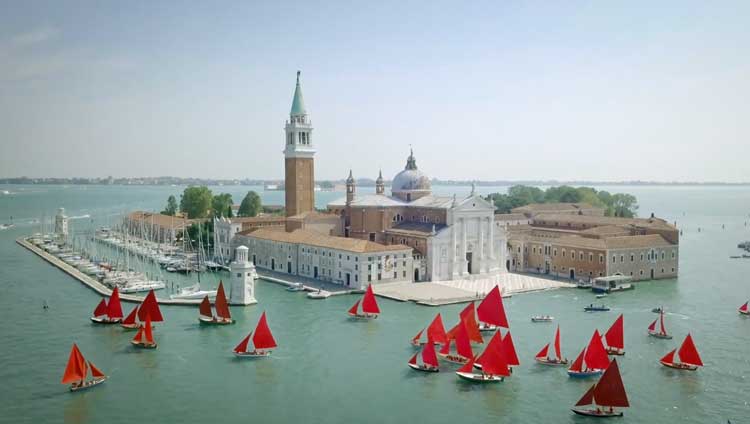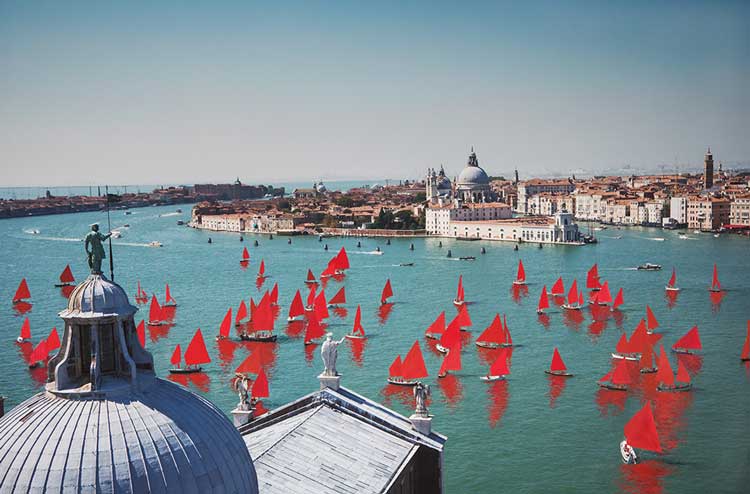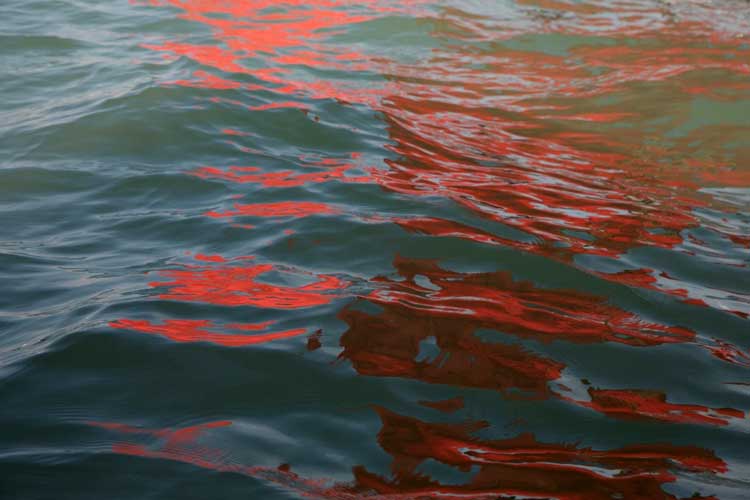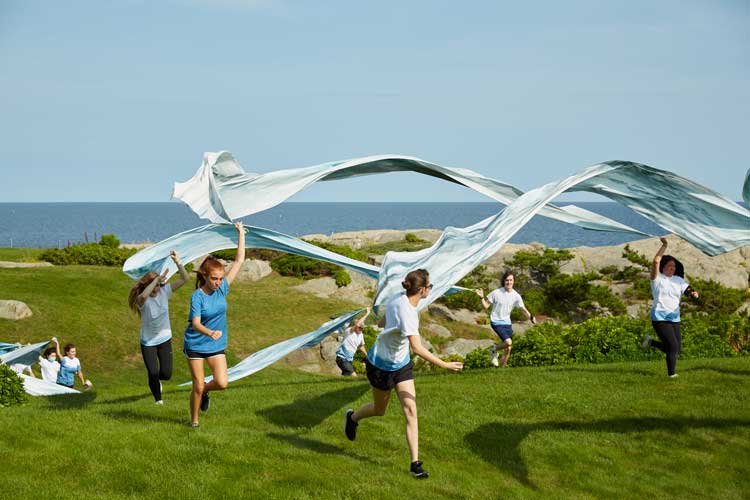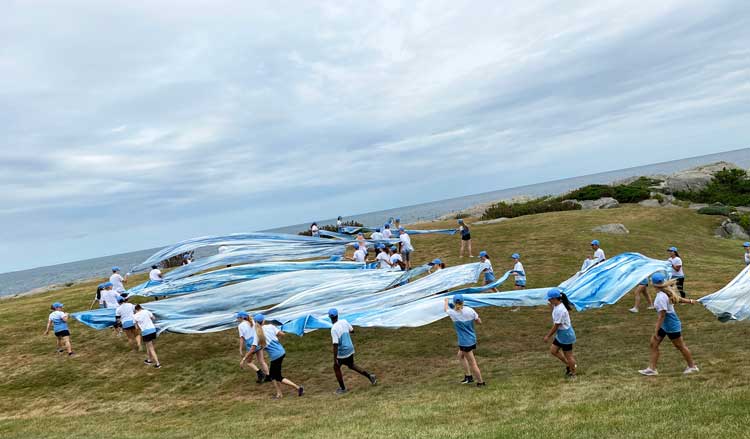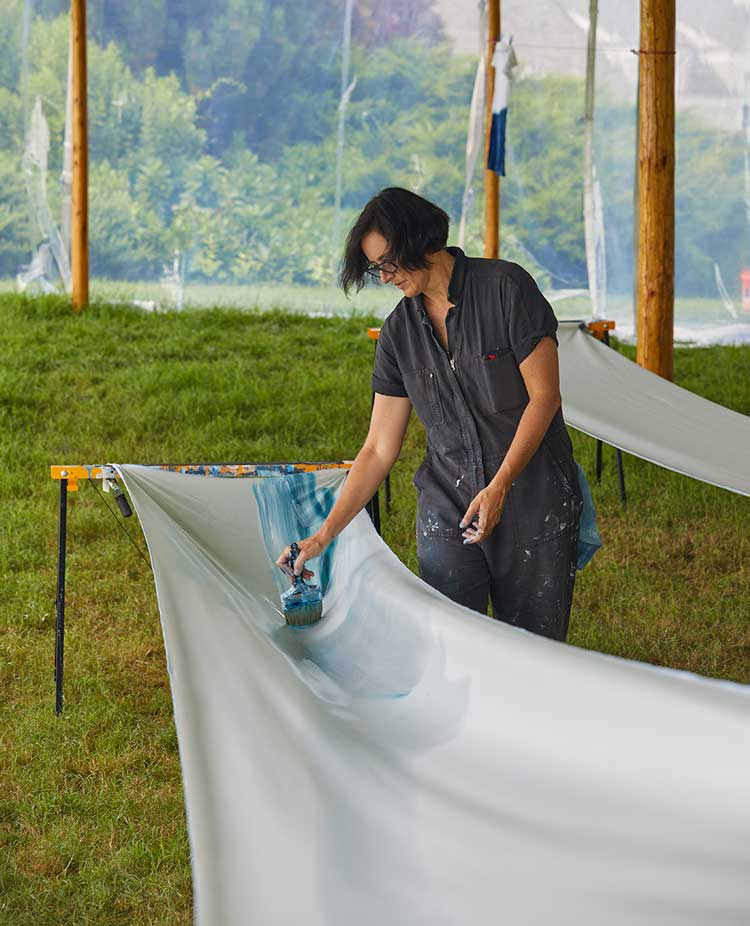

by NICOLA HOMER
The American artist Melissa McGill grew up sailing with her father in the Long Island Sound in her home near New York City. After graduating from the Rhode Island School of Design, she went to live in Venice, which drove her interest in environmental themes. Water is a strand that runs through her oeuvre, from her first large-scale public artwork, Constellation in New York (2015), to her sculptural sound project in Venice, The Campi (2017), and her community art project Red Regatta (2019), during the Venice Biennale, in which she explored a nautical sailing tradition in the face of climate change. In 2021, she produced In the Waves (2021), a series of public art performances involving a cast of local community members in Newport, Rhode Island, which drew attention to rising sea levels.
[image7]
Since 1991, McGill has exhibited her work nationally and internationally. This year, the interdisciplinary artist is presenting her works alongside topographical paintings of an Italian master in Canaletto and Melissa McGill: Performance and Panorama, at The Lightbox, Woking – which was placed firmly on the map of the UK’s regional art scene, after it won the Art Fund Prize Museum of the Year Award in 2008. The work is a conversation between the artists that bridges the gap of 250 years while exploring their shared appreciation of Venice. McGill has held a number of solo exhibitions, including shows at the Permanent Mission of Italy to the United Nations, New York; White Cube, London; Power House, Memphis; Palazzo Capello, Venice; and CRG Gallery, New York. McGill lives in Beacon, New York.
Studio International spoke by telephone to McGill about her artistic career and sources of inspiration. The following is an edited version of that conversation.
Nicola Homer: How did you start out as an artist?
Melissa McGill: Since I was little, I have always been interested in making things, a natural inclination. After I graduated from the Rhode Island School of Design with a fine arts degree in sculpture, I went to live in Venice for two years and this was pivotal. I graduated, got on a plane a week later and arrived in Venice – it was my first time in Europe – and I distinctly remember all the sensations: the sparkling of the sunlight on the water, the rhythms of the Venetian dialect, somebody walking by whistling, and there was the smell of the sea. It was a feast for the senses, basically. I lived in Venice for two years and travelled a little bit around Europe as well. This was 1991 to 1993 and, because I was alone and wasn’t with a school group, it worked out for the best, because I learned to speak Italian in Venice. I met a lot of Venetians who are still my friends. Red Regatta is a project that has been in development for my entire adult life, because I fell in love with the city and it has become like a second home.. Through my adult life, I have seen first-hand the changes happening to that city, whether they be environmental changes, the mass flood of tourism or ever-increasing motorboat traffic. At a certain point, I started a sound project called The Campi [a term used in Venice to describe the irregularly shaped public squares that serve as the historic heart of every Venetian neighbourhood]. One of the Campo Boxes is in Canaletto and Melissa McGill: Performance and Panorama. In the centre of the room of Canalettos, this sculptural sound box takes the form of the architectural footprint of the public square on which it is based, called Santa Maria Nova, and it emits recorded ambient sounds recorded in that place. I recorded them because I noticed the sounds in Venice were changing over time with mass tourism and the changes in the city, so I wanted to capture them. I chose a Campo that is vibrant with authentic Venetian sounds, Venetian everyday life, not the sounds of what it might sound like in the centre of San Marco with all the tourists. That was the first project I did in Venice, and it was curated by Chiara Spangaro and co-organised with Magazzino Italian Art.
NH: Would you say that the jumping-off point for your career was your time in Venice?
MM: It certainly had and continues to have a big impact. All my work is focused on water and Venice is known as the “city of water”. Water is a central influence on my work – it runs through the Constellation project, The Campi project, and the projects that I have coming up in the United States and Italy. I think my connection to water is very, very deep. Our bodies are something like 70% water, and I think that water in our bodies has a conversation with the water outside our bodies and I feel this very strongly. That connection to Venice was also coming from my upbringing and a relationship to the sea and sailing since I was a child.
[image6]
NH: Can you tell me about your independent public art project Red Regatta, which I gather American Vogue magazine described as “the toast of the Venice Biennale in 2019”?
MM: It was an independent project. It was not technically part of the biennale, but it was during the biennale, and it was a collaboration with the Associazione Vela al Terzo di Venezia, a boat club whose members own traditional wooden “vela al terzo” sailing boats. I met Giorgio Righetti, the former president (who has since passed on) during The Campi project, and Silvio Testa, another member of the boat association. They were passionate sailors, passionate about the lagoon. I had this idea of taking the Campo Box on a boat through the small, narrow canals of the city, because I wanted to hear the layered sounds of what was in the Campo Box, but layered with the sounds of the city and do a little film, which we did.
It was in the moment that I stepped into Giorgio Righetti’s boat for the first time that I just fell in love with it and asked them all about this tradition. They told me something that I found so inspiring: they spoke about the adaptability of this sailing tradition. For example, these wooden boats have a mast that can be taken down and laid in the boat, in order to row under the bridges and through the narrow canals of the city, and then put back up to sail in the lagoon. The tradition’s adaptability and sustainability and the perspective of water is so important. Vaporettos and gondolas are more well known, and I wanted to celebrate this inspiring tradition.
NH: The exhibition at The Lightbox features works from Red Regatta, including video, hand-painted photos, sound work, photography and watercolours. Can you talk about the creative process of making Red Regatta?
MM: It was a very challenging project. I led the production, assembled the team and raised the funding for the project. It was a huge collaboration with more than 250 Venetian partners and was presented in collaboration with Associazione Vela al Terzo, curated by Chiara Spangaro, with project manager Marcella Ferrari; the project was co-organised by Magazzino Italian Art, with support from Mazzoleni. It’s about us coming together to celebrate this Venetian tradition, the sustainability of it, but also to raise awareness and activate the energy around these urgent issues that Venice faces. In my development of the project, it was independent – it wasn’t associated with an institution. My hand-painted renderings were made as I was working to envision what this project would look like with all the different shades of red sails. Every boat had its own shade of red sails that was mixed especially for that boat and hand-painted during a workshop with the students and sailors. I consider the whole making of Red Regatta the project. While things were happening in Venice – the making of the sails and going through the process to organise the permissions – in my studio in New York, I was making a lot of the artworks, such as studies of the blue-green water of the Venetian lagoon, which are in the exhibition at The Lightbox. You see that same blue-green in the Canaletto works – it’s very distinctive.
[image4]
NH: How did you decide which type of media to use to express what you wanted to say?
MM: Well, there are different works that express different things. The watercolours I’m referring to were like studies of the water. Then there were the renderings, which were a study of what the project was going to look like, and then there were studies specific to phases of the project, such as Riflessi, the photographs I took of red reflections in the water. Those are works that I photographed from the boat during the sailing regatta. Those are the vibrant reflections appearing in that water all around me while I was in that. That is what it felt like to be in the middle of that project. And those pathways and reflections connected all the boats. You know how when you see the moonlight in the water, it connects you to the moon, it comes right to you? It’s the same effect of these reflections between the boats.
These red reflections on the water are reaching out in all directions and connecting all the boats visually. It’s also a great parallel to talk about the coming together of community members to do this project to raise the awareness about these environmental issues that affect the city. The city is fragile. They’re dealing with issues of climate change, mass tourism, the ever-increasing motorboat traffic. At the time that I did the project, the ratio of Venetians to tourists was one Venetian to every 358 tourists. Now it’s worse, the tourism this year since Easter has been so intense as people come back to travelling. You would think we would have learned something from the pandemic, but, no, and there is this flood of tourism that is really disruptive to the city and it’s just too much. I mean, honestly, all these issues are on-going, including the negative impact of the cruise ships. This is a fragile ecosystem and it needs to be protected, and the Venetian identity and culture needs to be protected. So, we were celebrating all of it in a very positive way to bring attention to what can we can do when we come together with shared values about the protection of, and respect for, the environment.
[image2]
NH: In the exhibition, your work is presented in the context of a conversation between you and the Italian landscape artist Canaletto, who was known for his topographical paintings in the 18th century and may have used a camera obscura. The imagery in the exhibition explores your shared appreciation of the historic city of Venice. How did you edit and sequence works for the exhibition to reveal affinities with the artist?
MM: I love that question. It’s a really interesting conversation over time between points of view. There in the room with the Canaletto works, and I decided to put the Campo Box in with them, so you hear the sounds of contemporary Venice in the middle of these incredible historic works and connecting past and present. Then there is the series of watercolours that are hung on either side of the doorway that leads from the works of Canaletto and the Campo Box into the Red Regatta works. I chose to put the watercolours on either side of the door because it’s almost as if you move through a wall of water. The colours connect directly to the Canaletto works. We sailed past the San Giorgio Maggiore church in Red Regatta and it is depicted in a few of the Red Regatta works. You see that same church in one of the Canaletto works in the exhibition. The same type of traditional boats can be seen front of the church in the lagoon in this Canaletto painting, hundreds of years before.
[image8]
Then you come into this room of Red Regatta works and you feel the vibrancy of the red, and there are the Riflessi works that I just described. There is a piece in this room called Acqua Alta, which I made after the Red Regatta project: photographs printed on glass, which lean on the wall allowing light to spill through and project on the wall. It’s interesting that you mentioned Canaletto’s camera obscura in relationship to this work, with the projection of watery colours. Water connects these works.
[image5]
Of course, there are other Canaletto works that are more urban studies, but there is a lot of capturing of everyday Venetian life,. I understand that scientists have used the Canaletto paintings recently to study algae levels at that time to understand more about water levels and measure rising seas over time.. That’s really interesting to think about how the city of Venice has changed because you just see some of the same kinds of boats, some of the same histories with the same buildings of this incredible historic city in the Canaletto paintings. But it’s also what has happened since then. How is Venice being seen now? How is Venice livable for the Venetians now? These are questions that I ask.
[image3]
NH: I’d be really interested to talk a bit more about what and who has inspired you in your artistic career. Can you talk about any artists who have been particularly important to you in your career?
MM: That’s a hard question. So many artists have been such a big influence. There is an artist named Maria Lai, who did a project called Legarsi alla Montagna, which means “To Tie Oneself to the Mountain”. I found out about this work from my friends at Magazzino Italian Art because they are passionate about her work. I didn’t know her work until a number of years ago. In 1981, she engaged her entire town in Sardinia to be part of this artwork where everybody worked together. A thousand citizens of Ulassai tied their Sardinian town to the nearby mountain with 17 miles of blue denim ribbon creating connection between humans and Mother Nature. We can’t be in the centre, we have to be part of the circle, right? In a symbiotic relationship. I loved the way that her project spoke to that. So, the themes of collective action, site specificity, connection to the landscape and authentic community engagement were all at the heart of that project.
[image11]
NH: That calls to mind your project In the Waves. I’m keen to talk to you about this, as it is a series of public art performances that explored the landscape and drew attention to rising sea levels, situated on ancestral land of indigenous peoples at Newport in Rhode Island. Can you tell me how you explored environmental themes in this performance-based work?
MM: I was invited to do that project by an organisation called Art&Newport and its curator, Dodie Kazanjian, along with the Newport Restoration Foundation. It was sited on a historic oceanfront property called Rough Point [the estate of Doris Duke] in Newport, Rhode Island. The project was free and open to the public and presented new perspectives through this collaborative public artwork. I did a public call, a casting call, in the community of Rhode Island. I was born in Rhode Island, but I’ve grown up in New York, so this was like a little bit of a homecoming for me. I was very drawn to the sea, of course, and there is my connection to the Atlantic Ocean and so on. I invited a cast of local participants to come and be the performers in this project. We did a series of performances with paintings that I painted on site, plein air style, as the weather changed every day, over the course of a few weeks. All the paintings were made on recycled ocean plastic textiles. It was a very silky fabric that was donated to me by Parley for the Oceans, an environmental organisation that collects plastic from the oceans, and fishing nets, a clean-up effort, and then they turn it into a textile. I used that instead of canvas or another fabric. These paintings were done on site and then activated through the landscape by the performers. It was a collaboration, an authentic community engagement. It was during Covid, so it was quite challenging to do a project like this at that time, but we managed it!
[image9]
NH: Does it consider themes of climate change?
MM: Yes, absolutely. Besides using this textile of ocean-recycled plastic, the performances activated the landscape, appearing like waves. You see that we were coming as a group with these wave paintings, through the landscape, because all these coastal communities are going to be dealing with rising seas. You know how you’ll hear language about the oceans or wind or storms or Mother Nature that’s very negative – sometimes, you’ll hear it being described as an aggressor? I don’t believe that’s fair or accurate because I think the changes that are happening in nature are largely caused by humans. We are affecting what is happening. To blame nature doesn’t make any sense to me. So, I don’t speak in those terms in my work. I’m in complete awe and respect for nature. I just got back from Iceland with my family and the magnificence of the landscape and geological time that you can feel there is astounding.
In the project In the Waves, I wanted to partner with members of the community and these paintings in the landscape to bring a different message. Each painting is carried by two performers. They are a trio, in stewardship. The people carrying the painting are bringing the waves, like partnering with a metaphor or a reference to the oceans. Then, of course, we are collaborating with the elements: wind, water, the sky, the view of the sky. Being a site-specific piece in the landscape, it’s like how does this work activate the landscape in a way that brings forward some of this reflective thinking and consideration? What can we do together, again? And not just a collaboration with people, but together in partnership and support of the natural elements.
[image10]
NH: I would be keen to talk about how Venice as a historic city has experienced rising sea levels during climate change. Red Regatta is the first artwork to be registered as a clean regatta, a programme led by the conservation organisation Sailors for the Sea, based in Rhode Island. I gather it encourages sailors to protect the ocean through education and activism. So, in light of this, would you agree that Red Regatta could be read as a call for action against climate change?
MM: Yes. It’s the first artwork to be registered as a “Clean Regatta”. I reached out to them because they have developed a series of best practices for sailing events. I always try to link together different organisations and invite in as many partners with shared values as possible into my projects, with aligned missions. It was a perfect way to bring in some of the best practices from this other organisation into this context. We collaborated with many organisations in the city of Venice, such as the Peggy Guggenheim Collection and Ocean Space. There were many partnerships in the project, including Classic Boats Venice. We came together to call attention to the forces of climate change and mass tourism that threaten Venice’s future. There were other programmes happening at that time of the project, spanning a wide age group. We had lots of young kids and people of all ages in the boats as crew. Then students who had participated in the sail painting workshop sailed with us in Red Regatta. The age range of the people painting was 18 to 78. It was like creating a big family through these projects. And that energy has carried forward beyond the project in ways that I never could have imagined when we were doing it. All the sails were given to the sailors after the project. They continue to use those sails. You know when you throw a stone into the water and it has these ripples? There continued to be ripples from Red Regatta. It’s become a symbol of hope and of a collaboration.
NH: Can you tell me about your recent work, These Waters (2022), an installation of photographs of the Hudson River in New York. I would be interested to talk about this in connection with your earlier public art project Constellation, installed around the ruins of Bannerman Castle on Pollepel Island in the Hudson River in 2015. Would you like to sum up how your exploration of water has evolved over recent years?
MM: Absolutely. I have a close connection with the Hudson River, because I live close to its banks. There is a park called Long Dock Park near where I live. I have spent a lot of time walking along the Hudson River in the mornings through the seasons over the last 16 years. This is an immersive installation of large-scale photographs that I took in the Hudson River in the winter. They lean against each other. This work is connected to Acqua Alta, mentioned previously. That work represents the tides and the flooding in Venice that happened after RedRegatta. It’s a conversation between light, transparency and ephemerality. There is a language of water there that becomes very immersive. It has this cosmic dimension where you have these starry bursts of light on the waves that connects the way the waves ripple with the starlight. Constellation works from that same point of view.
These Waters relates to Constellation, , my first large-scale public art work. It took place around a castle ruin on a small bedrock island on the Hudson River. I was curious about this site because when I first moved up to the Hudson Valley, I would pass it on the train and I would think: “What is this place?” Living in Beacon, right near there, I heard some stories about it, but there seemed to be a lot missing … more to understand about this place, and I was interested in the longer view. This was the point where I met members of the Lenape Center – the Lenape are the indigenous people of New York – and the Lenape Center is an organisation dedicated to the vibrancy of Lenape culture and its ongoing presence. I collaborated with the Lenape Center on Constellation and I am a member of its advisory board. We continue to collaborate.
Early on in the project’s development, Hadrien Coumans, one of the founders, took one look at my renderings for Constellation, and he said to me: “Oh, you’re making Opi Temakan!” And I said: “What is Opi Temakan?” He said that in Lenape it means: “It’s the White Road of Stars that connects this world to the spirit world.”
NH: What do you consider to be your greatest achievement as an artist to date?
MM: Well, an artist always hopes their greatest achievement is coming, that they haven’t done it yet, right? That’s why we work so hard. I have learned a tremendous amount through doing these public artworks. They are very challenging. They take a tremendous amount of dedication and energy. I’ve been honoured to work with all of my collaborators: the Lenape Center, the Associazione Vela al Terzo, Magazzino Italian Art, Mazzoleni and many others. There is a richness of community. One of the things that I’m most proud of is bringing these groups together to collaborate and through shared values to see how we can create positive change. There is a lot of talk about information and it’s difficult to address issues of climate change and mass tourism and rising seas, because when you say those things, people tend to glaze over, because they seem like abstract ideas. It’s important to find stories and traditions, and personal reflections to share in these topics, and see how we can activate to make change, how we can come together to do this. That is always my aim with my projects. The projects that I design have that at their centre.
NH: What artistic projects will you be working on next?
MM: Mazzoleni will feature works in the Armory Art Fair in September. These Waters will be exhibited at that time and some works that I’ve been doing in my studio for the past few years. I’ve been using a natural organic indigo pigment and they’re all paintings of waves and water, and they’re very vibrant and active and spirited. There is an energy coming from the water and these are coming out of my experience of close observation and experience of bodies of water in my life. I have a show in New York in September at the Totah Gallery in New York too. I am also working on two public art projects, a project that will be off the Hudson River and another project for Venice. Water continues to be my focus. I’m continuing with these topics I’m dedicated to. I have a lot of ideas about other things I want to do. My public art projects can take two to three years to produce, so I’m in the early stages. There is a lot of work coming.
• Melissa McGill will be at The Armory Show, New York, from 9 to11 September 2022. Melissa McGill: Currents is at the Totah Gallery, New York, from 8 September until 15 October 2022. Canaletto and Melissa McGill: Performance and Panorama is at The Lightbox, Woking, UK, until 13 November 2022.
• Melissa McGill: Red Regatta by Melissa McGill, Chiara Spangaro and Silvio Testa is published by Marsilio, price £47.50
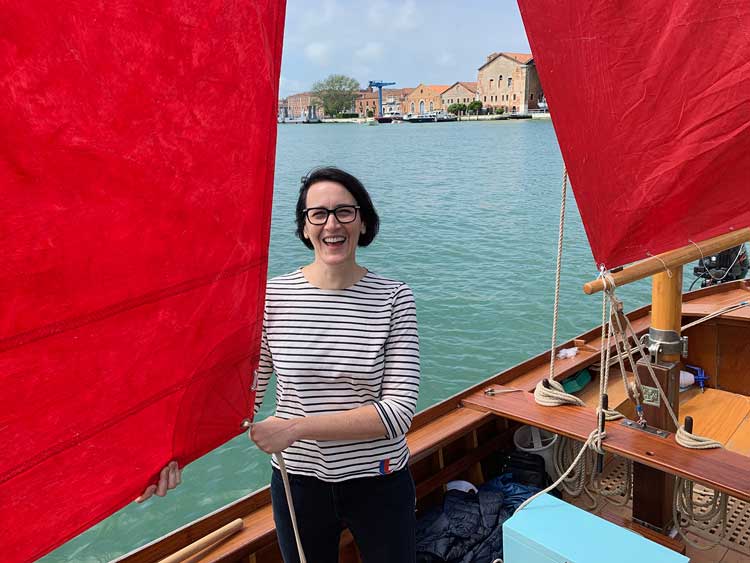
-The-Church-of-San-Giorgio-Maggiore,-Venice.jpg)
-Venice-The-Feast-Day-of-Saint-Roch,-about-1735-(c)-The-National-Gallery.jpg)
-The-Interior-of-the-Rotunda,-Ranelagh,-London,-1754,-oil-on-canvas-(c)-Compton-Verney.jpg)
